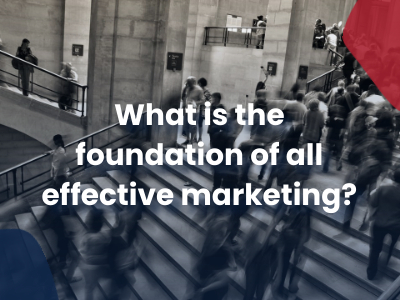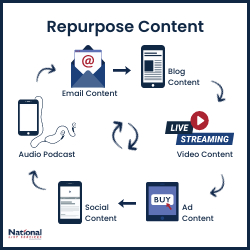What is the foundation of all effective marketing?

Most people’s favorite part of building a marketing campaign are the visuals. While how your marketing looks is important, who you are sending it to, and how you are sending it should be the first step with any marketing. Those two things inform everyone’s favorite part of marketing: results.
It’s like a luxury car…looks beautiful and sure makes an impression, but if there’s no gas in the tank, it won’t go anywhere. Going (hopefully fast) is the goal!
So, how do you know what the best fuel is for your marketing campaign?
The right fuel is determined by who your audience is, what your campaign objectives are, and the best ways to reach your audience.
Which comes back to the two most common questions we get asked:
- What data do I need for marketing?
- How do I reach my customers?
What data do I need for marketing?
Really the first question is: what data is available? Viant had a great illustration about the different types of marketing data.

Data Types (Explained with Cows)
First-Party Data
You own a cow. You know the cow’s name, what it eats and where it sleeps. These are your customers; you have their contact information in your CRM. They know you have their information.
Second-Party Data

You rent some cows from a friend for a fee but you don’t necessarily know the cow’s name, what it eats, or where it sleeps. You have to pay your friend each time you need some milk. Second-party data is first-party data sold to another company for a specific use. For example, say you own a company and you looking to expand into a new market. You can buy a list of first-party customer data from a company in the new market you are tapping into and market to them for an agreed-upon number of times. However, with the increased privacy and data laws using second-party data can sometimes be problematic.
Third-Party Data
There’s a village full of cows that were bought, rented, or found. The cows with similar traits are herded together and sold to you. You don’t know where the cows came from or sometimes if this is even a real cow. Traditional list data and many digital audiences call into this category. Which is one reason it’s so important to get data from a good source! You need to be able to trust that you aren’t buying fake cows or ones that don’t match the traits you need. Another thing to remember about 3rd party data is that it is the most impacted by the cookie and privacy laws! Relying too much on traditional 3rd party data can set you up for failure in the future.

Looking into the future with post cookie advertising, traditional 2nd and 3rd party data channels are going to change. The ways to gather consumer data have already changed in a lot of ways. For example, Connected TV doesn’t support cookies and instead relies on IP targeting. This is data you can use for marketing but doesn’t have the same types of information you would get with traditional list data. You are going to get demographic data and location data but probably not names or a specific address. Using IP targeting is a great way to maintain your same flow of data-driven campaigns while still working within updated privacy laws.
This is often called people-based data. When you use people-based data you know you are reaching real people in real households.
What data do you actually need?
The data you need is based on two things: What do you know about the people you are trying to reach? What is your goal with this campaign? What you know about who you are trying to reach impacts your demographics and helps informs decisions about methods and channels. Your campaign goal also helps you figure out what channels to use as well as campaign scale and message.
Questions you can ask to help learn about your customers:
- What are their basic demographics?
What gender to they identify as? How old are they? Where do they live? What is their relationship status? Are they educated? - What do they do for work?
What’s their job title and description? But more than that, are they a decision maker? What do they influence at work? - What are their interests?
Do they have hobbies or interests? What do they do in their free time? Are they part of a community? - What do they want and why can’t they have?
This a big thing for figuring out what you can do to help them! What are their goals and dreams? What are their pain points? Like, what keeps them up at night? - Why wouldn’t they buy from you?
What’s stopping them from buying from you? What objections may they have? - What ways would they prefer to interact with you?
Do they use social media? Do like a particular social media? Is a phone call the best way to reach them?
Learning about your customers and the best way to communicate with them is the foundation of effective marketing! Effective marketing = results!
Should You Repurpose Content?

So, should you repurpose content? Yes! Recycling or repurposing content has a lot more advantages than just saving time. (Although that is very helpful. As the old adage says… Time is Money! 💰 )
What does it mean to repurpose or recycle content? There are a couple ways to do it. One way is to repost or reshare the content as is. A lot of companies do this with TBTs or just highlighting past content. Another way to repurpose content is to take old content and use it as an outline for new content.

For example, once a Live Video stream is over, the audio can be published as a podcast on platforms like Spotify or Apple Music. Video clips of highlights can be repurposed into social content or ads. As well as pull quotes. The transcript can be turned into a blog article.
(This article is based off an outline for a live video, that was in turn, based off another blog article, that was itself based off one of Live Roundtables. Content can generate other content.)
What’s Your Message?
If you have been making content for a while, you probably have a good idea of what your message is. So, no matter what you do, some part of everything you create will be a reiteration of something you’ve said better before. That’s a good thing! Constantly adding drastically different messaging can create a confusing overall brand message. Your brand pillars and values aren’t going to change so your general message probably won’t either.
For example, the foundation for everything we do is using accurate data to create effective marketing. All the content we create is in some way or another connected to that. Therefore, it makes sense that we reiterate ideas and messages. That doesn’t mean that we don’t have anything new to say because there are always new ways of approaching information. The world around us, as well as technology and industry standards are always changing. There are always new things that can be added. Adding information keeps your messages up to date. Up-to-date content is more accurate and provides for value to your followers.
Your Audience Grows and Changes
Another reason to recycle content is that it gives more people an opportunity to see it. And even if someone has been following you for a long time there’s a good chance that they didn’t see the content the first time around. Social media platforms notoriously fail to consistently promote content. And we are all busy, it’s easy to miss something. And your followers might appreciate or need a piece of content now, more than they did when it was first published. Repurposing the information is a way to help your customers get the information they need.
Know What Your Customers Need
The more times goes on, the more you know about your audience’s interests. We are all constantly learning about our followers and audience. The more time goes on the more First Party Data is available. Knowing more about who your customers are can help you to understand what content they actually need. You can then reframe the information that you know would more benefit them.
Recycling Content Boosts SEO
One added benefit of repurposing content is that it boosts SEO. Search engines like to see a lot of content that revolves around a single topic. It shows a consistent brand message and purpose. A consistent brand message can indicate brand value.
What ways do you repurpose content?
Save 80% Time & Money: How to Market to the Crucial 20%
 Wouldn’t we all like to save 80% of our time, money and marketing effort, while getting 10 times or even 100 times the results?
Wouldn’t we all like to save 80% of our time, money and marketing effort, while getting 10 times or even 100 times the results?
However, that’s just what Cara accomplished. Let’s see how she did it, and how easily you can do the same.
Starting out, Cara did what most failing marketers do… she found a “deal” renting a cheap list of 5000 prospects for 20 cents per name. It cost her an extra dollar per person to get the offer in front of her list. Total cost: $5500. Since 40 people bought her product at $100 profit each, she got $4000 back for her effort.
Poor Cara. She lost $1500 on this campaign. (Okay, I rounded the numbers, but this is really close to what happened.) Sadly, she thought her target audience should be “everyone interested in my product.” But the school of hard knocks really motivated her to take a closer look at buyer personas and exactly who her ideal audience is.
“What things do I need to look at to find my ideal customers?” Excellent question, Cara.
Fortunately, she found a great data provider who guided her through modelling tools and buyer propensities. Cara selected a list of only 500 prospects. Sure, these extra data analytics cost $2 per name instead of 20 cents each. Was it worth it?
Well, considering she spent the same dollar per person to get her offer in front of the new list, her total cost was $1500. This time, she sold to 30 people, making sales totaling $3000. Yay for Cara! This time, instead of losing, she doubled her money.
Really though, she saved 73% of her marketing cost. And she converted 7.5 times as many prospects into sales. But, you may say, how could you get 100 times the results? Another great question.
We’ve all heard of Mr. Pareto. The original 80/20 guy. Truth is, his principle can be applied to itself. Not only will 20% of your best prospects give you 80% of your profits… The top 4% of your prospects will give you 64% of your profits. (20% of 20% and 80% of 80%.)
Wow.
So, if you can identify the top 20% of your best prospects, you can really be 16 times more profitable. And if you identify the top 4% of your prospects…wait for it…you can be 250 times more profitable . If you are not following this formula, “you are leaving millions on the table,” says Brian Kurtz, Executive Vice President of Boardroom Inc. and leading direct marketing expert.
Don’t think it’s that valuable to niche down this much? Look at Amazon. They specialize in one tiny niche after another. And even a decade ago, that’s how they sold 50% of their books. Even small businesses can compete with large companies by targeting a smaller niche like this.
How can you make this easy for your business?
 Let’s say you’re the Dallas Cowboys. Most fans will get into the stadium for $19. Some of them will get $1000 season tickets for the mediocre seats. Only a few will get the $10,000 seats near the 50-yard line. And a tiny fraction of them will dish out far more money than this to enjoy the ultra-exclusive sky boxes. How much will a raving football fanatic (with money) spend on football? A virtually unlimited amount. You want to find THIS kind of people. And you CAN (and should) find them.
Let’s say you’re the Dallas Cowboys. Most fans will get into the stadium for $19. Some of them will get $1000 season tickets for the mediocre seats. Only a few will get the $10,000 seats near the 50-yard line. And a tiny fraction of them will dish out far more money than this to enjoy the ultra-exclusive sky boxes. How much will a raving football fanatic (with money) spend on football? A virtually unlimited amount. You want to find THIS kind of people. And you CAN (and should) find them.
Even if you’re only the company selling the peanuts.
Ask yourself about demographics: Who are your best customers? How old are they? Where do they live? What about their gender, income level, education, family/marital status, occupation and ethnic background? Now, ask yourself about their motives. What makes them buy? What is their personality, attitudes, values, interests/hobbies, lifestyle and behavior?
How can you know this stuff?
It’s not as hard as you might think to learn the right way to use a propensity modelling tool. Or some brand new (and yet relatively inexpensive) methods to give you real behavior data on your ideal customers.
Stay tuned.
Or better yet, call us. We’re happy to walk you through our tools right now.
| Click here to learn more |
